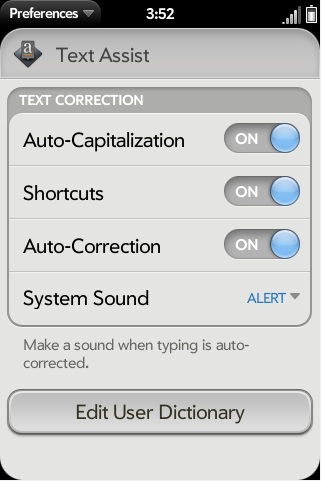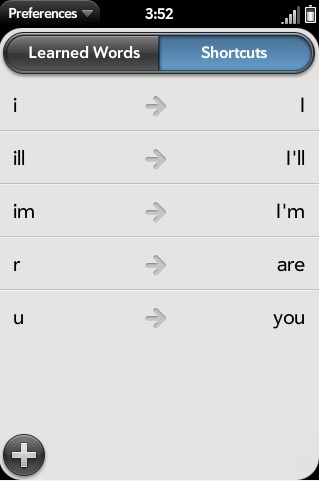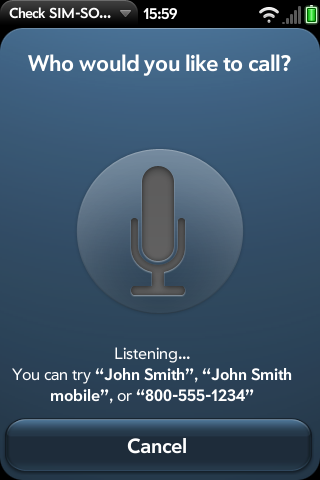webOS 2.0 Overview
by Mithun Chandrasekhar on February 3, 2011 6:05 PM ESTOther Updates
Overall, the UI has been polished up in webOS 2.0. While I cannot comment on the performance because of the non-final software I was running, the transition animations themselves appeared very smooth. HP has also updated certain HTML 5 features supported by webOS and rolled in the popular node.js Javascript framework runtime into webOS 2.0, thereby letting developers come up with their own background services in Javascript, in addition to the applications themselves. There are also a couple of other consumer-facing updates that are worth mentioning.
Although all webOS devices to date (all of two!) have had physical keyboards, spelling correction has been absent in webOS until now. Whether this is because we’ll be seeing keyboard-less webOS devices in the future or because HP thought it would be a good idea to include it anyway, we finally have a spell-check in webOS. Dubbed “Text Assist”, it performs the usual gamut of auto-corrections and lets you enter a list of user defined words.


Text Assist makes its (useful) debut on webOS 2.0
The one nice touch I most definitely appreciate here is the ability for the user to define word shortcuts. The user can now define mappings between shorthand words and how they’re supposed to be auto-corrected. “im” will become “I’m”, “were” will be set to “we’re” etc. where appropriate.
A sorely missing feature in webOS that HP has finally added is voice dial and command. By virtue of this, they have opened up developer access to the device mic. This will certainly bring in a flurry of VOIP apps, with Skype confirming that it will release a version of its app for the webOS platform (although it looks as though it will be restricted to Verizon-only devices, at least initially). This definitely fills a void in the webOS platform that has been open for far too long.



(Left)Voice dial, (Center) Favorites, (Right) dialer app now in blue
The final big update webOS 2.0 brings along with it is the inclusion of Flash 10.1 support. Yes, after multiple “It’s coming soon” promises, this iteration of webOS finally adds Flash support. Now you might be shocked to see this listed way down here, almost towards the end of the article, but there is a reason for this.
As I had mentioned earlier, we didn’t get a Pre 2 device for this article. I made use of the beta webOS 2.0 SDK and a “doctored” version of webOS 2.0 on my Pre Plus. Because of this, I could not get a true representation of the performance of the Flash implementation in webOS 2.0. This was because the SDK would be running on a full-fledged computer and the version of webOS 2.0 I had running on my Pre Plus was definitely not final.
That being said, I could see the all-important banners and short clips without much trouble. However, full-blown Flash videos were definitely choppy, with gesture controls (zoom, scroll etc.) not working. I will put this down to the beta-ness of the build and more importantly the fact that the Pre Plus only has an OMAP 3430 down-clocked to 500Mhz. Because a webOS 2.0 compatible build of Uberkernel is not around yet, I could not see if overclocking the CPU made it better in any way or form.










46 Comments
View All Comments
ssj4Gogeta - Thursday, February 3, 2011 - link
Well, that sounds pretty bad. Google needs to advertise Android as a Google product. That will definitely help.Belard - Friday, February 4, 2011 - link
"4 OS Smartphones"? Uh, theres more than 4 on the market. But if WebOS(HP) can make a dent in the market place, it would be 6th major contender. Linux would be 7th and its dying out - killed by Android (Which is based off Unix).Around 2010, the smart phones :
1 - 36% = Symbian (Nokia - blah)
2 - 25% = Android (Samsung, Motorola, LG, HTC, SONY)
3 - 17% = iPhone
4 - 15% = RIM (Blackberries)
5 - -3% = Windows Mobile
6 - 2% = Linux (and getting smaller)
7 - -1% = WebOS 1.x and everything else including Sony's old system.
WebOS 2.0 is competing with 4~5 solid major competing systems.
A bit of fun. First SMART Phone is by IBM. The Simon from 1994. It has a huge mono-LCD touch screen, no actual buttons. Use your finger or a stylus to operate.
Looking at the screensshots, it looks great. Clean and simple. In ways, there are still issues with Android. I'm still on 2.1 with my Galaxy which isn't perfect, other than its screen.... and there are some interface issues that are harder than it should be.
Setting up an alarm, in which the screen button display is alpha numeric?!
rhangman - Friday, February 4, 2011 - link
Don't forget Samsung Bada. Surprisingly decent OS and the hardware is essentially the same as their Android/WM7 phones.Conficio - Thursday, February 3, 2011 - link
I like webOS too. sounds quite a bag of good ideas.But the hardware spec seems to be last years boat. by the time that hits the networks we are talking about dual core A9, etc.
The interesting part would be if HP could use this to build UIs for all its devices: phone, tablet, printer, scanner, monitor/TV remote, monitor OSD, cameras, notebook instant on, netbook instant on, etc.
Ahh, and make it open source and engage many hardware manufacturers. Google has done it, webOS does need too.
One more question, what is the app install story/marketplace? That is key for developers, isn't it?
Cyborg7th - Friday, February 4, 2011 - link
The pre's specs are last years boat... or more to the point, mid 2009. But at the time of release it was just as powerful, and in some areas better, than the other phones on the market.HP does plan on using webOS on tablets and printers so far that I know of, and possibly more in the future.
As for open source, webOS has Android blown away in that department. I have full access to everything on my pre, including a terminal interface which I can run shell commands on. Thanks to the homebrew guys/gals you can change almost everything on the phone, including overclocking it. My pre is curretly clocked at 1 ghz with custom voltages.
The last question is where I feel HP needs to step up their game on the software side of things. The current app store sucks to be blunt. I never use it anymore after loading preware onto my phone. But while webOS doesn't have a ton of apps available, a lot of them are free.
ChronoReverse - Friday, February 4, 2011 - link
That seems like a curious thing say about "blowing away Android" when the examples you provided are all possible on Android as well. Perhaps you meant to say iOS?Cyborg7th - Saturday, February 5, 2011 - link
Possible on Android... sure... now get back to me when you can do it without rooting your phone first.tenkom - Saturday, February 5, 2011 - link
It is not exactly officially supported on webos either and over clocking does require you to flash a new kernel. Many android phones are very easy to root so I don't think that is a very good argument.Cyborg7th - Saturday, February 5, 2011 - link
That was the arguement to begin with. My statement was about webos being more open than android. Out of the box, webos on any of the phones does not have to be rooted.Conficio - Thursday, February 3, 2011 - link
I'd think that many of these app features would be great as kind of a dashboard on Windows/Linux as well.So make a virtual phone as a dashboard (many laptops have multi finger mousepads and desktops start using it too - Apple?). Then sync the the phone and the dashboard app, allow any sort of sizing, make it a screensaver, etc.
Same for media access on your media settop box?
HP has the ability to do it, especialy if they OSS it.